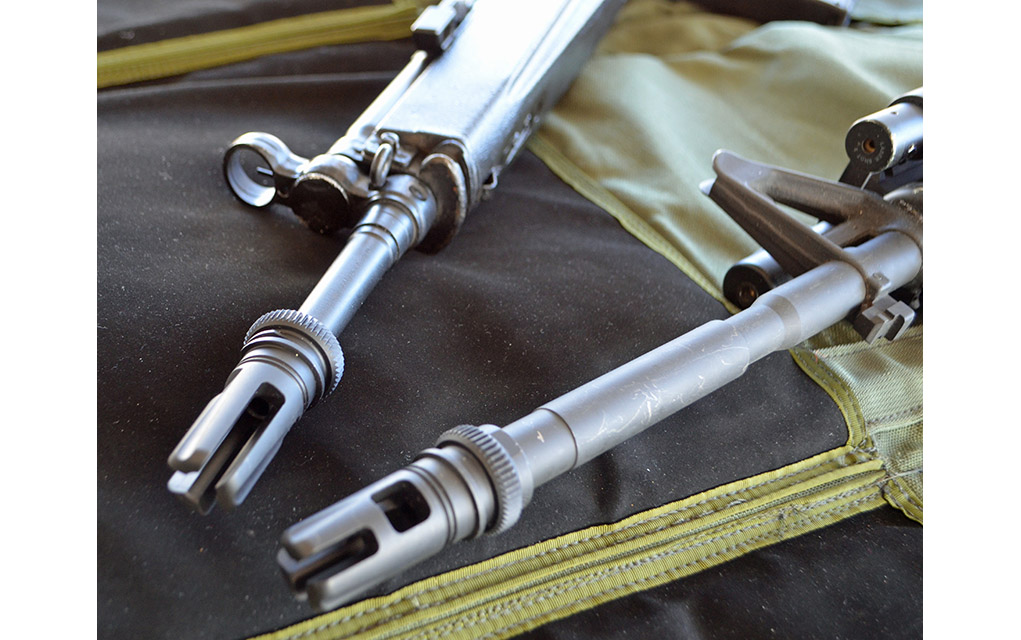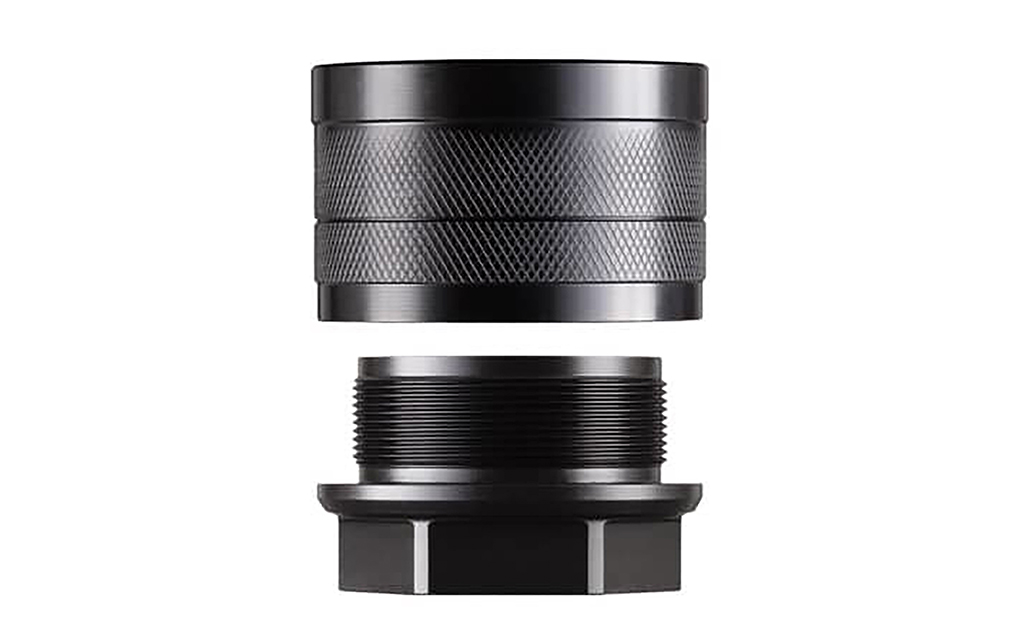Attaching a suppressor to a barrel shouldn’t be complicated, but it often is. Here we give an overview of the most common types of suppressor mounts.
Do you think I need to go with a QD- or a HUB-style mount on my suppressor? What about direct-thread, is that even a thing anymore?”
Chances are good that, if you know little about silencers or have stepped away for a few years, that previous sentence sounded like absolute gibberish. However, it’s not something uncommon to hear when you’re around a group who knows their stuff when it comes to mounting a can to the barrel of a firearm.
For better or worse, there are many ways you can attach a suppressor to a firearm. Each one has its pluses and minuses … and those considerations should play an important role when it comes to your decision making.
Direct-Thread Attachment
At one time, the most common method of suppressor attachment was directly threading a can to a barrel. Just like the name suggests, you have a threaded barrel that accepts the female threads of the suppressor you want to attach. If your only exposure to silencers has been through movies and television shows, this is probably the method you have seen on screen.

However, the thread pattern can vary, depending upon the barrel diameter and caliber of the firearm in question. At one time, it was a potluck among thread patterns, as factory-threaded barrels were a rarity on most firearms from the inception of the National Firearms Act in 1934.
Perhaps the introduction of the AR-15 rifles in 1960, with their ½x28-inch thread pattern, made this more popular as silencer developers pursued military contracts.
The benefits of a direct-thread mounting system allow easy installation and removal via the common threads. Often, with precision type shooting, this is a desirable method, as the silencer indexes on the muzzle in the exact same position every time it’s reattached.
Direct-thread attachment is also usually the cheapest method, as the QD and HUB systems that we’ll look at next feature the added expense of purchasing mounts and adapters that are fairly costly for what they are.


Drawbacks to the direct-thread method include the threat that the threads can have the potential to strip or cross and become misaligned. This is usually only seen with older machinery cutting the barrel threads at the factory, or by a gunsmith, and the lathe or dies are not completely within specifications.
Another potential issue with this attachment system was that a shooter could place an incorrect caliber silencer on the wrong firearm. Calibers such as .22 LR, 5.56 NATO and 9mm Luger, for example, all share a common thread pattern of ½x28. To their credit, Colt briefly threaded the 9mm versions of the AR-15/M16 in ½x36 to bypass this issue.
The only other issue of concern here can be that some shooters find direct-thread mounting to be time consuming while attaching, depending upon the length of the threads. Some of us like to think of them as a basic—but somewhat universal—solution, depending on the thread pattern and what it fits.
The QD Mount
When suppressors and “modern sporting rifles” made their big comeback in the early 2000s, there was an issue regarding the direct-thread style of attaching a can to a rifle. Many of these rifles had timed flash suppressors or muzzle brakes installed that had to be removed and typically installed again after the silencer was no longer in use. Additionally, many shooters in this niche would move one suppressor around to different rifles that shared the same thread pattern.


The easiest way to solve this issue was to use a muzzle device that had external threads, so the suppressor would quickly attach to the device threads as opposed to the barrel threads.
These types of silencers would oftentimes use an additional method of retention, such as a ratchet or a latch to secure the silencer, as opposed to just a few coarse threads.
A rather unique solution was developed by Heckler & Koch for use on the MP-5, known as the Tri-Lug. For this mount, the barrel of the MP5 had three fins, or lugs, which allowed a suppressor with a female corresponding part to close over and secure to it, by giving the silencer a quick twist under spring tension. Attachment and detachment could be accomplished in a few seconds. The biggest pitfall to this type of system was regular, ongoing maintenance of the spring.
An unexpected bonus for shooters using the QD mounting system was that certain suppressors of a larger caliber could be used on smaller caliber rifles … if there was a common external size to the mounts. So, a .30-caliber silencer intended for .308 Winchester could be paired with a rifle chambered in 5.56 NATO with common-sized QD mounts. This was a huge value for shooters, who could now move one silencer among a score of different rifles, so long as they invested in that system.


Another worthwhile mention here, particularly if investing in an older model that may be discounted, is to opt for the muzzle brake version of the mount as opposed to a flash hider—especially if the baffles are made of something expensive, like Inconel or titanium—and you’re pairing it to a rifle that shoots full auto or has a short barrel. The brake, being made of steel, will act as a shield to the muzzle blast. This is what’s known as a sacrificial baffle, as it takes the brunt of that initial blast and reduces wear on the first baffle in the can.
The primary issue with any of the QD methods was that there was no uniformity across the board for silencer manufacturers. In certain cases, the mount had as much time and input into development of the mounting system as they did with the silencer itself.
With certain QD mounts, there was the issue of the suppressor not correctly indexing to the same point consistently, especially if it was a ratcheting type. This would often shift the shooter’s point of impact.
Around a decade ago, while working with a major silencer distributor, a question was asked: “Why don’t all these manufacturers just use a common mounting system?” After all, when you’re testing different silencers on different rifles and pistols and the mounts need to be timed or glued in with Rocksett or Loctite with different degrees of torque, it can seem like a large investment of time to change out these systems. This carries over if you’re a dedicated shooter with multiple silencers by different manufacturers.
The answer was, “I don’t think we’ll ever see that in our lifetimes.”
HUB (Hybrid Universal Base)
But, things started to change around 2014.


That was the year SilencerCo came out with a suppressor known as the Omega 300, built around a base called the Bravo Mount. The Omega 300’s Bravo Mount used a 1.375×24-inch thread pattern. A year later, the company unveiled the Hybrid 46 with the same thread design … and the Hybrid 46 was key to what would happen next.


The Hybrid 46 was the most universal silencer available when it was launched. It could handle almost any rifle caliber, from 5.56 NATO to .308 Winchester—as well as .45-diameter calibers, like .45-70 and .458 SOCCOM. A different base with a piston allowed it to work on centerfire handgun cartridges, too, such as 9mm and .45 ACP. It could be said that the Hybrid 46 not only handled all these different calibers, but it handled them all well.


And this was how the HUB-style mounting system was born. The Hybrid Universal Base (HUB) promotes similar can dimensions and a 1⅜x24-inch thread pattern. Because its capabilities were so prolific, many other suppressor manufacturers were eager to adapt to the system.


The HUB gives shooters the ability to match almost any suppressor to a firearm without being married to any manufacturer for the sake of a $100 mount on every rifle … and then having to change mounts with the purchase of a new silencer. It’s the first true plug-and-play method for most silencers on the market today.
Future Trends
With the acceptance of the HUB and the dominance of direct-thread suppressors, along with the bulk of QD mount-dedicated silencers in the wild, it’s difficult to predict any future advancements, apart from simple improvements on the HUB. If any change might be implemented on a broad scale, it would need to come from firearm manufacturers en masse.
For example, changing barrel threads on rifles from a right-hand pitch to a left-hand pitch might be better as a base-mounting solution, since the adapter would not come loose with the silencer during removal.


There’s currently a clip-on design made in Austria, known as the Limex MKD44, designed for the Glock 44 model in .22 LR. This suppressor attaches to the Picatinny rail of the pistol, has a huge internal volume, and seems to be very effective at noise reduction. It could resolve issues with aftermarket thread barrels that might not be concentric. Plus, it could eliminate the need for suppressor-height sights if its development was picked up in the United States by a good manufacturer.
Apart from those potential rumblings, the next stage of can-mounting innovation might possibly have to wait until the time when our laser sights can silently poke holes in things … or we can set phasers to stun.
Editor’s Note: This article originally appeared in the 2025 suppressor special issue of Gun Digest the Magazine.
More On Suppressors:
Read the full article here








